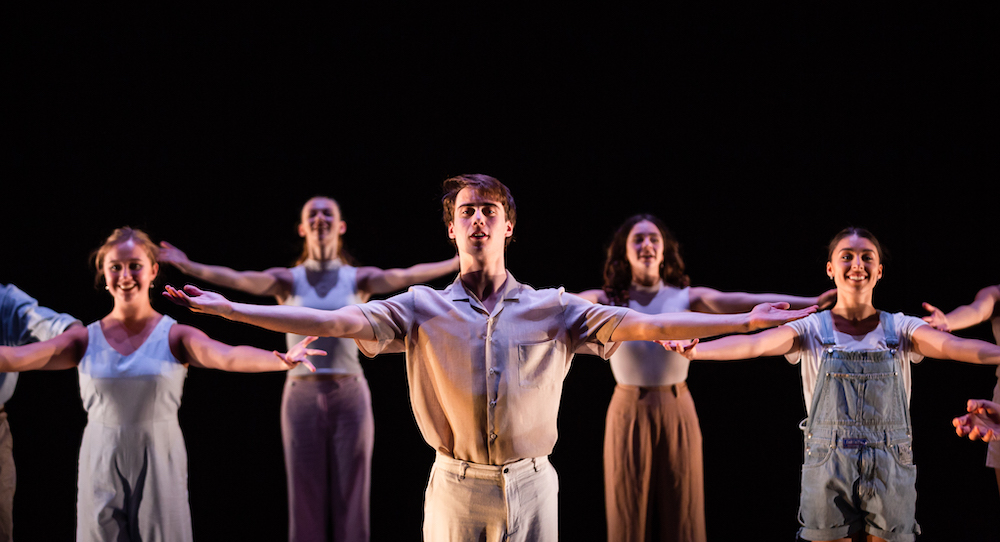West Australian Academy of Performing Arts (WAAPA) is a thriving university arts conservatory in urban Perth, Western Australia. It’s well known for music theatre and dance streams, as well as having an extremely strong acting, and indigenous theatre stream and curriculum.

WAAPA students. Photo by Stephen Heath Photography.
WAAPA is also a destination choice for many dancers, because of its Perth location. It’s a long way to the west, but the remoteness is part of the attraction, and part of the WAAPA identity. Dance Informa wanted to find out about the WAAPA experience. Here, we speak with a current WAAPA student, a recent graduate and staff.
An average day at WAAPA usually consists of approximately four-and-a-half hours of practical classes, one academic class and an hour-long lunch break, according to 19-year-old first year student Elah Hirschberg. “Our first class starts at 9am, but most of the dancers are in the studio half an hour early to warm up,” she explains. “We usually have classes until 5:30 in the evening, but Thursday and Friday afternoons are used for rehearsals for our end-of-semester shows. I have been dancing from the age of four, dance is my passion, and I hope to pursue it as a career in the future. I decided to come to WAAPA because I felt it would provide me with the experience and skills I need to be a successful dancer and prepare me for entry into the industry.”

Ballet class at WAAPA.
She continues, “Initially what attracted me to the course is that it nurtures the physical, intellectual and creative sides of a dancer. While the technique classes are aimed at honing our skills, choreography and improvisation classes encourage us to think out of the box. Academic subjects such as anatomy, music and dance history provide us with the knowledge we need to be healthy, proactive and cultured artists.”
Danielle Hunt, lecturer in ballet at WAAPA, says that she loves that students she teaches have chosen to do this full-time and that they can be taught in a academy with the best facilitates and resources. “To my knowledge, WAAPA is the only full-time ballet training institution in Australia that offers a University (Bachelors) degree for ballet dancers,” says Hunt, who danced with The Australian Ballet before joining WAAPA, where she currently teaches classes in ballet technique, pointe work, repertoire and solos.

Danielle Hunt.
Hunt says that she is eagerly anticipating the end-of-year ballet production. “For the last five years, I have had the opportunity to co-stage the end-of-year ballet production. I enjoy the challenge of being involved in the casting, staging and reorganising some of the choreography to match the particular talents and strengths of the students. It is always hugely rewarding seeing them perform and grow on stage each night.”
Hirschberg says one of her favourite classes is improvisation. “It challenges me physically and mentally and pushes me out of my comfort zone,” she reveals. “It teaches me how to think on my feet, respond to visual, auditory, ideational and textural stimuli, and adapt to any situation. It gives me the freedom to develop my own movement language and discover who I am as an artist. I think that this class is essential, especially with the increase in the number of choreographers who require their dancers to improvise as part of the creative process.” After she graduates, Hirschberg says she would like to join a contemporary company or work as a freelance artist.

Scott Elstermann. Photo by Tyrone Robinson.
Scott Elsterman is a recent grad from WAAPA and is currently working as an independent artist. “I’m juggling lots of different balls,” he says, “performing, choreographing, teaching. Since WAAPA, I have performed for Lucy Guerin Inc, Natalie Allen and Shona Erskine and had the chance to create numerous short works. Most recently, I was selected to perform excerpts of Merce Cunningham repertoire at the National Gallery of Australia, Canberra.”
Elsterman says he misses the people at WAAPA. “You form such close bonds with your classmates and teachers, dancing and living in one another’s hip pockets for three years, and now everyone has spread out across the world. I also miss having a guaranteed dance class every day.”

WAAPA visiting artist Niv Marinberg. Photo by Kathy Wheatley.
Elsterman says that some of the best preparations for a career came from working with various choreographers in WAAPA’s performance seasons. “It opened up your eyes to different creative processes and how to adapt to different situations. For example, remounting a work from a video, tasking new material, working with others artists. The arts management unit has also helped with writing grant applications, and the choreography unit solidified an interest in creation and what type of artist I want to be.”
For more information on the West Australian Academy of Performing Arts, visit www.waapa.ecu.edu.au.
By Tamara Searle of Dance Informa.















